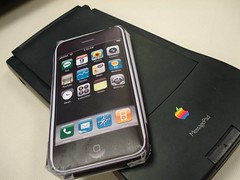
The above shot was taken on Sunday’s Macsurfer homepage. Just look at those headlines. If that isn’t a PR nightmare for Apple, I don’t know what is. This after they did such a super job before the iPhone 3G was announced.
Fortune talked about the perils of “event marketing” – how, yeah, a big huge event like this is fun and draws attention, it’s catastrophic when something breaks down. As it did on Friday. Apple is an expert at drawing press attention. That only makes the scrutiny laser beam that much hotter.
Despite everything that happened, it could’ve been worse. But I’m starting to wonder how. Just from personal experience, this week has been a bummer with my Apple gear. First, I updated my Airport Express base station’s firmware. Afterward, the thing crashed, and now I can’t use my external USB hard drive.

The update must have damaged my USB drive somehow, because I had to repair the thing in Disk Utility and now iPhoto crashes every time it tries to load my library from the disk. Even worse: my iBook and Airport Utility won’t even recognize the base station:

So much for a helpful “update.”
Then, after I thought MobileMe was actually giving me a chance to try it out (I set up my account, and could log in online), I find out that OS X 10.4 has issues connecting with MobileMe. In fact, the .Mac icons won’t even change over:

Just when it looks like MobileMe (or .Mac, or .Whatever) is going to sync my contacts and calendars and whatnot, I get this:

At least this is just the 60 day trial. If I were paying for this, I would not be a happy Apple customer.
And that’s just it. Even amidst Friday’s hellbroth during the iPhone 3G launch, I still played the dedicated Apple soldier. Most of the folks in line with me understood, too, that these things happen, and we were still a part of Something Special. But when the nuts of bolts of Apple’s operation start to come undone, that’s when you get people angry. People will stand in line for hours for the iPhone, no matter what activation issues are taking place, with a gritted smile on their face. That smile soon disappears, however, when basic things like Airport and “Exchange for the rest of us” (more like, “for the most patient of us”) start breaking down.
Apple has got a mess on its hands, it seems, and I wouldn’t want to be their PR department for the next week or so. The least they should do is offer some sort of apology, admit their mistakes, and fix their damn software. Those are the basics.
Do that, and we might forget our USB drive crashing through Airport Disk Utility. Might.

















